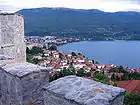Ohrid
Ohrid (Macedonian: Охрид [ˈɔxrit] (![]() listen)) is a city in North Macedonia and is the seat of the Ohrid Municipality. It is the largest city on Lake Ohrid and the eighth-largest city in the country, with the municipality recording a population of over 42,000 inhabitants as of 2002. Ohrid is known for once having 365 churches, one for each day of the year, and has been referred to as a "Jerusalem of the Balkans".[2][4] The city is rich in picturesque houses and monuments, and tourism is predominant. It is located southwest of Skopje, west of Resen and Bitola. In 1979 and in 1980 respectively, Ohrid and Lake Ohrid were accepted as Cultural and Natural World Heritage Sites by UNESCO. Ohrid is one of only 28 sites that are part of UNESCO's World Heritage that are Cultural as well as Natural sites.[5]
listen)) is a city in North Macedonia and is the seat of the Ohrid Municipality. It is the largest city on Lake Ohrid and the eighth-largest city in the country, with the municipality recording a population of over 42,000 inhabitants as of 2002. Ohrid is known for once having 365 churches, one for each day of the year, and has been referred to as a "Jerusalem of the Balkans".[2][4] The city is rich in picturesque houses and monuments, and tourism is predominant. It is located southwest of Skopje, west of Resen and Bitola. In 1979 and in 1980 respectively, Ohrid and Lake Ohrid were accepted as Cultural and Natural World Heritage Sites by UNESCO. Ohrid is one of only 28 sites that are part of UNESCO's World Heritage that are Cultural as well as Natural sites.[5]
Ohrid
| |
|---|---|
.jpg.webp) .jpg.webp) .JPG.webp) .jpg.webp)  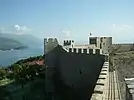 .jpg.webp)  Ohrid and Lake Ohrid | |
| Nickname(s): | |
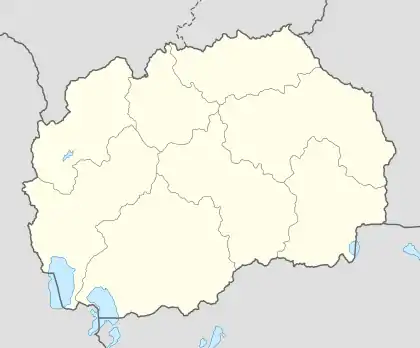 Ohrid Location within North Macedonia | |
| Coordinates: 41°07′01″N 20°48′06″E | |
| Country | |
| Region | |
| Municipality | |
| Government | |
| • Mayor | Konstantin Georgieski |
| Area | |
| • City | 383.93 km2 (148.24 sq mi) |
| Elevation | 695 m (2,280 ft) |
| Population (2002) | |
| • City | 42,033 |
| • Density | 142.97/km2 (370.3/sq mi) |
| • Metro | 51,367 |
| Time zone | UTC+1 (CET) |
| Postal codes | 6000 |
| Area code(s) | +389 046 |
| Climate | Cfb |
| Patron saints | Saint Clement and Saint Naum |
| Website | https://ohrid.com.mk/ |
| Official name | Natural and Cultural Heritage of the Ohrid region |
| Type | Natural, Cultural |
| Criteria | i, iii, iv, vii |
| Designated | 1979 (3rd session) |
| Reference no. | 99 |
| State party | North Macedonia |
| Region | Europe and North America |
| Extensions | 1980, 2019 |
Name
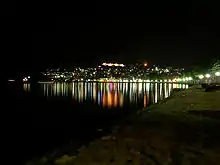
In antiquity the city was known under the ancient Greek name of Λυχνίς (Lychnis) and Λυχνιδός (Lychnidos) and the Latin Lychnidus,[6][7] probably meaning "city of light", literally "a precious stone that emits light",[8] from λύχνος (lychnos), "lamp, portable light".[9] Polybius, writing in the second century BC, refers to the town as Λυχνίδιον - Lichnidion.[10] It became capital of the First Bulgarian Empire in the early medieval period, and was often referred to by Byzantine writers as Achrida (Ἄχριδα, Ὄχριδα, or Ἄχρις).[11][6] By 879 AD, the town was no longer called Lychnidos but was referred to as Ohrid.[12][13] In Macedonian language and the other South Slavic languages, the name of the city is Ohrid (Охрид). In Albanian, the city is known as Ohër or Ohri and in modern Greek Ochrida (Οχρίδα, Ωχρίδα) and Achrida (Αχρίδα).
History
Illyrians (Enchele, Dassaretii) –3rd century BC
Roman Republic 3rd century BC–27 BC
Roman Empire 27 BC – 395
Byzantine Empire 395–842
First Bulgarian Empire 842–1018
Byzantine Empire 1018–1083
Bohemond I 1083–1085
Byzantine Empire 1085–1203
Second Bulgarian Empire 1203–1208
Strez 1208–1214
Epirus and Thessalonica 1214–1230
Second Bulgarian Empire 1230–1263
Byzantine Empire ~1250–1334
Serbian Empire 1334 - ~1336
Gropa family ~1336 – ???
Lordship of Prilep ??? – ~1373
Gropa family ~1373–1395
Ottoman Empire 1395–1912
Kingdom of Serbia 1912–1915
Kingdom of Bulgaria 1915–1918
Kingdom of Yugoslavia 1918–1941
Kingdom of Bulgaria 1941–1944
SFR Yugoslavia 1944–1991
Macedonia/North Macedonia 1991–present
Antiquity
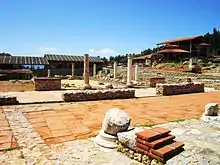
The earliest inhabitants of the widest Lake Ohrid region were the Illyrian tribes of Enchele[14] and Dassaretii.[15][16] According to a tradition the town, called Lychnidos (Ancient Greek: Λυχνιδός) in classical antiquity, was founded by the Phoenician king of Thebes, Cadmus who, banished from Thebes, in Boeotia, fled to the Enchele to the north and founded Lychnidus on the shore of Lake Ohrid and Budva in Montenegro.[17][18] Lychnidos was the capital city of the Illyrian Dassaretii.[15][16]
According to recent excavations this was a town as early as of the era of king Phillip II of Macedon.[19] They conclude that Samuil's Fortress was built on the place of an earlier fortification, dated to 4th century BC.[19] In 210 BCE, Philip V of Macedon raided a number of southern Illyrian communities. He maintained a garrison at Lychnidus but lost control of the settlement in 208 BCE, when its commander joined local leader Aeropus and invited the Dardani in the region.[20] During the Roman conquests, towards the end of 3rd and the beginning of 2nd century BC, Lychnidus is mentiond as a town near or within Dassaretia. In Roman times it was located along the Via Egnatia, which connected the Adriatic port Dyrrachion (present-day Durrës) with Byzantium.[15][16] Archaeological excavations (e.g., the Polyconch Basilica from 5th century) prove early adoption of Christianity in the area. Bishops from Lychnidos participated in multiple ecumenical councils.
Middle Ages
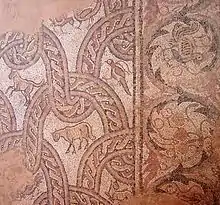
The South Slavs began to arrive in the area during the 6th century AD. By the early 7th century it was colonized by a Slavic tribe known as the Berziti. Bulgaria conquered the city around 840.[21] The name Ohrid first appeared in 879. The Ohrid Literary School established in 886 by Clement of Ohrid became one of the two major cultural centres of the First Bulgarian Empire. Between 990 and 1015, Ohrid was the capital and stronghold of the Bulgarian Empire.[22] From 990 to 1018 Ohrid was also the seat of the Bulgarian Patriarchate.[23] After the Byzantine reconquest of the city in 1018 by Basil II, the Bulgarian Patriarchate was downgraded to an Archbishopric of Ohrid, and placed under the authority of the Ecumenical Patriarch of Constantinople.
The higher clergy after 1018 was almost invariably Greek, including during the period of Ottoman domination, until the abolition of the archbishopric in 1767. At the beginning of the 16th century the archbishopric reached its peak subordinating the Sofia, Vidin, Vlach and Moldavian eparchies, part of the former medieval Serbian Patriarchate of Peć, (including Patriarchal Monastery of Peć itself), and even the Orthodox districts of Italy (Apulia, Calabria and Sicily), Venice and Dalmatia.
As an episcopal city, Ohrid was a cultural center of great importance for the Balkans. Almost all surviving churches were built by the Byzantines and by the Bulgarians, the rest of them date back to the short time of Serbian rule during the late Middle Ages.[24]
Bohemond, leading a Norman army from southern Italy, took the city in 1083. Byzantines regained it in 1085. In the 13th and 14th century the city changed hands between the Despotate of Epirus, the Bulgarian, the Byzantine and the Serbian Empire, as well as local Albanian rulers. In the mid-13th century Ohrid was one of the cities ruled by Pal Gropa, a member of the Albanian noble Gropa family.[25] In 1334 the city was captured by Stefan Uroš IV Dušan and incorporated in the Serbian Empire.[26] After Dusan's death the city came under the control of Andrea Gropa, while after his death Prince Marko incorporated it in the Kingdom of Prilep.[27] In the early 1370s Marko lost Ohrid to Pal II Gropa, another member of the Gropa family and unsuccessfully tried to recapture it in 1375 with Ottoman assistance.[28] In 1395 the Ottomans under Bayezid I captured the city which became the seat of the newly established Sanjak of Ohrid. In 14–15 September 1464 12,000 troops of the League of Lezhë and 1,000 of the Republic of Venice defeated a 14,000-man Ottoman force near the city in the Battle of Ohrid which ended in an Albanian victory over the Ottomans. When Mehmed II returned from Albania after his actions against Gjergj Kastrioti Skanderbeg in 1466 he dethroned Dorotheos, the Archbishop of Ohrid, and expatriated him together with his clerks and boyars and considerable number of citizens of Ohrid to Istanbul, probably because of their anti-Ottoman activities during Skanderbeg's rebellion when many citizens of Ohrid, including Dorotheos and his clergy, supported Skanderbeg and his fight.[29][30][31]
Modern
The Christian population declined during the first centuries of Ottoman rule. In 1664 there were only 142 Christian houses. The situation changed in the 18th century when Ohrid emerged as an important trade center on a major trade route. At the end of this century it had around five thousand inhabitants. Towards the end of the 18th century and in the early part of the 19th century, Ohrid region, like other parts of European Turkey, was a hotbed of unrest. In the 19th century the region of Ohrid became part of the Pashalik of Scutari, ruled by the Bushati family.[32] After the Christian population of the bishopric of Ohrid voted on a plebiscite in 1874 overwhelmingly in favour of joining the Bulgarian Exarchate (97%), the Exarchate became in control of the area.[33] In 1889, according to a French research, the city had 2.500-3.000 houses and approximately 12.000 individuals, of which 2/3 were Bulgarians and Vlachs and the rest 1/3 were Albanophone Muslims with 20-25 Slavophone Greek families.[34] In statistics gathered by Vasil Kanchov in 1900, the city of Ohrid was inhabited by 8000 Bulgarians, 5000 Turks, 500 Muslim Albanians, 300 Christian Albanians, 460 Vlachs and 600 Romani.[35] Before 1912, Ohrid was a township center bounded to Monastir sanjak in Manastir Vilayet (present-day Bitola). The city remained under Ottoman rule until 29 November 1912, when the Serbian army took control of the city during the Balkan Wars and later made it the capital of Ohrid district. In Ohrid, Serbian forces killed 150 Bulgarians and 500 people consisting of Albanians and Turks.[36] In September 1913 local Albanian and pro-Bulgarian Internal Macedonian Revolutionary Organization leaders rebelled against the Kingdom of Serbia. It was occupied by Kingdom of Bulgaria between 1915 and 1918 during World War I.
During Kingdom of Yugoslavia Ohrid continued to be as an independent district (Охридског округа) (1918-1922), then it became a part of Bitola Oblast (1920-1929), and then from 1929 to 1941, Ohrid was part of the Vardar Banovina. It was occupied again by Bulgaria between 1941 and 1944 during World War II. Since the days of SFR Yugoslavia Ohrid has been the municipal seat of Municipality of Ohrid (Општина Охрид). Since 1991 the town was part of the Republic of Macedonia (now North Macedonia).
On 20 November 1993, Avioimpex Flight 110 crashed near Ohrid, killing all 116 people on board. It is the deadliest aviation disaster to occur in North Macedonia.[37]
Geography and climate
Ohrid is located in the south-western part of North Macedonia, on the banks of Lake Ohrid, at an elevation of 695 meters above sea level.
Ohrid has a warm-summer mediterranean climate (Köppen climate classification: Csb), bordering on an oceanic climate (Köppen climate classification: Cfb) moderated by its elevation, as the mean temperature of the warmest month is just above 22 °C (71.6 °F) and every summer month receives less than 40 millimetres (1.6 in) of rainfall. The coldest month is January with the average temperature 2.5 °C (36.5 °F) or in a range between 6.2 °C (43.2 °F) and −1.5 °C (29.3 °F). The warmest month is August with average range of 27.7 °C (82 °F)-14.2 °C (57.6 °F). The rainiest month is November, which sees on average 90.5 mm (3.6 in) of rain. The summer months of June, July and August receive the least amount of rain, around 30 mm (1.2 in). The absolute minimum temperature is −17.8 °C (0.0 °F) and the maximum 38.5 °C (101.3 °F).
| Climate data for Ohrid | |||||||||||||
|---|---|---|---|---|---|---|---|---|---|---|---|---|---|
| Month | Jan | Feb | Mar | Apr | May | Jun | Jul | Aug | Sep | Oct | Nov | Dec | Year |
| Average high °C (°F) | 6.2 (43.2) |
7.6 (45.7) |
11.0 (51.8) |
15.1 (59.2) |
20.4 (68.7) |
24.8 (76.6) |
27.6 (81.7) |
27.7 (81.9) |
23.6 (74.5) |
17.7 (63.9) |
11.6 (52.9) |
7.2 (45.0) |
16.7 (62.1) |
| Average low °C (°F) | −1.5 (29.3) |
−0.9 (30.4) |
1.2 (34.2) |
4.6 (40.3) |
8.7 (47.7) |
12.0 (53.6) |
14.0 (57.2) |
14.2 (57.6) |
11.2 (52.2) |
7.2 (45.0) |
3.1 (37.6) |
0.0 (32.0) |
6.2 (43.2) |
| Average precipitation mm (inches) | 53.7 (2.11) |
60.2 (2.37) |
55.9 (2.20) |
55.9 (2.20) |
56.7 (2.23) |
33.5 (1.32) |
30 (1.2) |
30.6 (1.20) |
47.9 (1.89) |
76.1 (3.00) |
90.5 (3.56) |
71.3 (2.81) |
662.3 (26.09) |
| Average precipitation days | 11 | 12 | 11 | 13 | 12 | 8 | 6 | 6 | 7 | 10 | 12 | 13 | 121 |
| Source: World Meteorological Organisation (UN)[38] | |||||||||||||
Demographics

As of the 2002 census, the city of Ohrid has 42,033 inhabitants and the ethnic composition was the following:[39]
- Macedonians, 33,791 (80.4%)
- Albanians, 2,959 (7.0%)
- Turks, 2,256 (5.4%)
- others, 3,027 (7.2%)
The mother tongues of the city's residents include the following:
- Macedonian, 34,910 (83.1%)
- Albanian, 3,957 (9.4%)
- Turkish, 2,226 (5.3%)
- others, 1,017 (2.4%)
The religious composition of the city was the following:
- Orthodox Christians, 33,987 (80.9%)
- Muslims, 7,599 (18.1%)
- others, 447 (1.1%)
The oldest inhabitants of Ohrid are a few families that reside in the Varoš neighbourhood.[40] Other Macedonians have settled in Ohrid and originate from the villages of the Kosel, Struga, Drimkol, Debarca, Malesija and Kičevo regions and other areas from southern Macedonia.[40] In 1949, additional families from Aegean Macedonia settled in Ohrid.[40]
The presence of the Turkish community dates from their settlement in Ohrid during 1451–81.[40] All Turks from the village of Peštani after selling properties and land moved to Ohrid by 1920 and today those few families are known as Peştanlı.[41]
Albanians in Ohrid originate from Albanian villages located on the western and southern areas of Lake Ohrid.[40] There is a sizeable amount of Turkified Albanians in Ohrid who originate from the cities of Elbasan, Durrës and Ulcinj.[40] Orthodox Albanians are also present and settled in Ohrid during the second half of the 19th century and originate from Pogradec, Lin, Çërravë and Peshkëpi.[40]
The local Romani population in Ohrid originates from Podgradec and speaks the southern Tosk Albanian dialect.[40] In the latter decades of the 20th century, some Albanian speaking Muslim Romani from the villages of Krani and Nakolec have migrated to Ohrid.[42] In Yugoslav censuses, Albanophone Ohrid Romani mainly declared as Albanians.[43] As tensions between Albanians and the state increased over numbers regarding community size and sociopolitical rights, Romani identity became politicized and contested from the 1990s onward.[43] Ohrid Albanophone Romani refused identification as Albanians seeing it as a result of Albanisation (or to be called Gypsies) and with encouragement from Macedonian circles now refers to itself as Egyptians whose ancestors migrated from Egypt many centuries ago.[43] The Albanian language is considered by Ohrid Albanophone Romani as only an idiom of the home and not a mother tongue.[43] Turkish speaking Romani reside in Ohrid that during the Yugoslav period self declared themselves mainly as Turks,[40] while within independent Macedonia they identify as Egyptians.[43]
The earliest presence of the Aromanian population in Ohrid dates to 1778 arriving from Voskopojë, others from Kavajë (late 18th century), from the Myzeqe region, Elbasan, Llëngë and Mokër region (mid. 19th century) and also from Gorna Belica and Malovišta (late 19th century).[40] A large part of Ohrid's Aromanian population has emigrated to Trieste, Odessa and Bucharest.[40]
Main sights

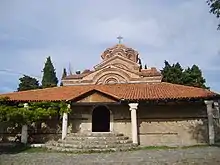
There is a legend supported by observations by the 17th century Ottoman traveler Evliya Çelebi that there were 365 chapels within the town boundaries, one for every day of the year. Today this number is significantly smaller.
- Church of St. Sophia
- Church of Saints Clement and Panteleimon
- Church of St. John at Kaneo
- Church of St. George
- Church of St. Zaum[44]
- Icon Gallery-Ohrid
- Monastery of Saint Naum
- Church of St. Petka
- Church of St. Stefan
- Vestiges of basilicas from the early-Christian time, e.g. Basilica of St. Erazmo (4th century)
- Robevi family house, museum of archeology
- Ancient Theatre of Ohrid
- Church of St. Vrači, with frescos from the 14th century. A 14th-century icon from the church is depicted on the obverse of the 1000 denars banknote, issued in 1996 and 2003.[45]
Besides being a holy center of the region, it is also the source of knowledge and pan-Slavic literacy. The restored Monastery at Plaošnik was actually one of the oldest Universities in the western world, dating before the 10th century.
Ohrid is also home to Vila Biljana, which serves as an official residence of the President of North Macedonia.
Transportation
There is a nearby international airport, Ohrid Airport (now known as "St. Paul the Apostle Airport") that is open all year round.
Until 1966, Ohrid was linked to Skopje by the Ohrid line, a 167 kilometres (104 mi) long 600 mm narrow-gauge railway.
Sports
GFK Ohrid Lihnidos is a football team playing at the SRC Biljanini Izvori stadium in the city. As of the 2019–20 season they play in the second tier of the Macedonian Football League system.
RK Ohrid is a handball team playing at Biljanini Izvori Sports Hall arena, with a capacity of 3,500. As of the 2016–17 season they play in the Macedonian Handball Super League, which is the top tier.
The Ohrid Swimming Marathon is an international open water swimming competition, always taking place in the waters of Lake Ohrid. The swimmers are supposed to swim 30 km (19 mi) from the monastery of Saint Naum to the Ohrid harbor.
Recurring events
- Ohrid Summer Festival, annual theater and music festival from July to August
- Ohrid Choir Festival, annual international choir festival at the end of August
- The Balkan Festival of Folk Songs and Dances, annual folklore music and dance festival at the beginning of July
- Balkan music square festival, music festival in August in which ethnic musicians from the whole Balkan peninsular participate
- Ohrid Fest (Охридски Трубадури), music festival in August in which musicians from the whole Balkan peninsular participate. This festival is held for four days which are divided into
- Debutant Night,
- Folk Night,
- Pop Night and
- International Night.
- World Prized of Humanism in the Ohrid Academy of Humanism, created by Jordan Plevnes
- Ohrid art and scientific meetings (Охридска научна и уметничка визита), held in House of Uranija-MANU,Ohrid by Macedonian academy of science and arts
International relations
Twin towns – Sister cities
Ohrid is twinned with:
|
Gallery
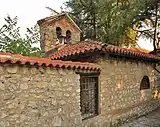 Holy Virgin Mary Bolnička church
Holy Virgin Mary Bolnička church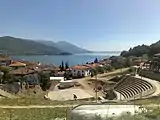 View of the Ancient Theatre of Ohrid
View of the Ancient Theatre of Ohrid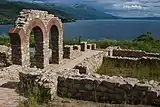 Archeological site of Plaosnik
Archeological site of Plaosnik Cliff in Ohrid
Cliff in Ohrid Street in the old town
Street in the old town Harbour
Harbour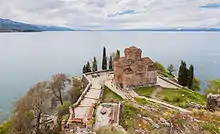 The Church of St. John at Kaneo high above the lake
The Church of St. John at Kaneo high above the lake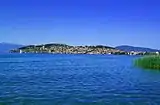 Lake Ohrid with the city in the distance
Lake Ohrid with the city in the distance Interior of the Samuil's Fortress
Interior of the Samuil's Fortress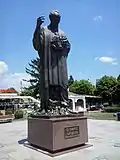 Monument of Saint Clement of Ohrid
Monument of Saint Clement of Ohrid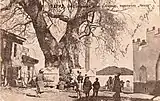 Postcard of Ohrid, Plane Tree, from 1922
Postcard of Ohrid, Plane Tree, from 1922 Postcard of Ohrid, photo taken in 1930
Postcard of Ohrid, photo taken in 1930 Postcard of Ohrid from 1930s
Postcard of Ohrid from 1930s.jpg.webp) Church of Saints Clement and Panteleimon by night
Church of Saints Clement and Panteleimon by night.jpg.webp)
See also
References
- Press online Gradovi u jesen (in Serbian)
- "The Mirror of the Macedonian Spirit, Zlate Petrovski, Sašo Talevski, Napredok, 2004, ISBN 978-9989-730-38-2, page 72: "... and Macedonia in the Cathedral Church St. Sofia in the Macedonian Jerusalem — Ohrid..."
- Dnevnik newspaper - Interview with the ambassador of Israel to Macedonia Archived 28 September 2011 at the Wayback Machine (in Macedonian)
- Biljana Vankovska; Hakan Wiberg; Wiberg Hakan (2003). Between Past and Future: Civil-military Relations in the Post-communist Balkans. Bloomsbury Academic. p. 71. ISBN 978-1-86064-624-9.
- Natural and Cultural Heritage of the Ohrid region
-
 Smith, William, ed. (1854–1857). "Lychnidus". Dictionary of Greek and Roman Geography. London: John Murray.
Smith, William, ed. (1854–1857). "Lychnidus". Dictionary of Greek and Roman Geography. London: John Murray. - Lychnĭdus, Harry Thurston Peck, Harpers Dictionary of Classical Antiquities (1898), on Perseus
- λυχνίς, Henry George Liddell, Robert Scott, A Greek-English Lexicon, on Perseus
- λύχνος, Henry George Liddell, Robert Scott, A Greek-English Lexicon, on Perseus
- Polybius. The Histories. 34.12.
- Anna Komnene, Alexiad, 13; Cedrenus, Synopsis historion, vol. ii. p. 468, ed. Bonn; John VI Kantakouzenos, History, 2.21.
- Evans, Thammy, Macedonia, Bradt Travel Guides, 2012, p.173
- "Ohrid Vacation, Travel, Tourism, Visit Ohrid - Official Web Site of the Municipality of Ohrid". www.ohrid.com.mk. Archived from the original on 26 June 2010. Retrieved 23 January 2016.
- Aufstieg und Niedergang der römischen Welt: Geschichte und Kultur Roms im Spiegel der neueren Forschung, Hildegard Temporini, Wolfgang Haase, Walter de Gruyter, 1983, ISBN 3-11-009525-4, p. 537
- Šašel Kos, Marjeta (2005). "Lychnidus". In Hubert, Cancik; Schneider, Helmuth; Salazar, Christine F. (eds.). Brill's New Pauly, Antiquity, Volume 7 (K-Lyc). Brill's New Pauly. 7. Brill. p. 913. ISBN 9004122702.
Lychnidus (Λυχνιδός, Λυχνίς, Lychnidós, Lychnís), Capital city of the Illyrian Dassaretae (→ Dassaretia) on the → via Egnatia (Str. 7,7,4; It. Ant. 318), modern Ohrid in Macedonia on Lake Ohrid.
- Fasolo, Michele (2009). "La via Egnatia nel territorio della Repubblica di Macedonia". In Cesare Marangio; Giovanni Laudizi (eds.). Παλαιά Φιλία [Palaià Philía]: studi di topografia antica in onore di Giovanni Uggeri. Journal of Ancient Topography - Rivista di Topografia Antica (in Italian). 4. Mario Congedo editore. p. 606. ISBN 9788880868651.
La via proseguiva verso Ohrid, la città sul sito del-l'antica Lychnidòs, antica capitale della tribù illirica dei Dassareti.
- Wilkes 1992, pp. 98-99.
- Greek Anthology Book 7, § 7.697
- "Culture — Republic of Macedonia". culture.in.mk. Archived from the original on 2 December 2008. Retrieved 13 October 2008.
- Wilkes 1992, p. 170.
- Dimitar Bechev, Historical Dictionary of the Republic of Macedonia, Historical Dictionaries of Europe, Scarecrow Press, 2009, ISBN 0810862956, p. xx.
- Old Hermit's Almanac by Edward Hays,1997,ISBN 978-0-939516-37-7, page 82: "... He sent word to Samuel, the ruler in the Bulgarian capital of Ohrid, that he was returning 15,000 of his prisoners of war. ..."
- Paul Robert Magocsi, Historical Atlas of Central Europe, (University of Washington Press, 2002), 10.
- UNESCO World heritage site for World heritage travellers, Ohrid region.
- Lala, Etleva; Gerhard Jaritz (2008). "Regnum Albaniae and the Papal Curia" (PDF). Central European University. p. 59. Retrieved 3 February 2011.
- Dobson, Richard Barrie (2000). Encyclopedia of the Middle Ages. Editions du Cerf. p. 1044. ISBN 978-1-57958-282-1. Retrieved 19 April 2011.
- Soulis, George Christos (1984). The Serbs and Byzantium during the reign of Tsar Stephen Dušan (1331-1355) and his successors. Dumbarton Oaks Library and Collection. p. 142. ISBN 978-0-88402-137-7. Retrieved 16 April 2011.
- Tsvetkov, Plamen S. (1993). A history of the Balkans: a regional overview from a Bulgarian perspective. EM Text. p. 219. ISBN 978-0-7734-1956-8. Retrieved 19 April 2011.
- Shukarova, Aneta; Mitko B. Panov; Dragi Georgiev; Krste Bitovski; Academician Ivan Katardžiev; Vanche Stojchev; Novica Veljanovski; Todor Chepreganov (2008), Todor Chepreganov (ed.), History of the Macedonian People, Skopje: Institute of National History, p. 133, ISBN 978-9989-159-24-4, OCLC 276645834, retrieved 26 December 2011,
deportation of the Archbishop of Ohrid, Dorotei, to Istanbul in 1466, to-gether with other clerks and bolyars who probably were expatriated be-cause of their anti Ottoman acts during the Skender-Bey’s rebellion.
- Srpsko arheološko društvo (1951), Starinar (in Serbian), Belgrade: Arheološki institut, p. 181, OCLC 1586392,
После борби које је водио султан Мехмед против Скендербега 1466 године. Пошто је победио Скендербега, султан је, у повратку, преселио известан број грађана и свргнуо охридског архиепископа Доротеја. Очигледно је, да су бар извесни Охриђани покушали да се ослободе Турака и да су и да су помагали борбу Скендербега. Исто тако је јасно да је ову акцију помагао и охридски архиепископ Доротеј.
- Institut za balkanistika (1984). Balkan studies. Bulgarian Academy of Sciences. p. 71. Retrieved 9 January 2012.
Mehmed II moved considerable number of prominent Ohrid families. The cause for that was the worsening of the relations between Ottoman authorities and Ohrid archbishopic... were in favor of helping the struggle of Albanian people
- Iseni, Bashkim (2008). La Question Nationale En Europe Du Sud-Est: Genese, Emergence Et Developpement de L'Identite Nationale Albanaise Au Kosovo Et En Macedoine. Peter Lang. p. 120. ISBN 978-3-03911-320-0. Retrieved 23 December 2010.
- Църква и църковен живот в Македония, Петър Петров, Христо Темелски, Македонски Научен Институт, София, 2003 г.
- G. A. Mano, Résumé géographique de la Grèce et de la Turquie d’Europe, «Collection des Résumés géographiques», Paris 1826, t. 5, p. 545.
- Vasil Kanchov (1900). Macedonia: Ethnography and Statistics. Sofia. p. 252.
- Kramer, Alan (2008). Dynamic of destruction: Culture and Mass killing in the First World War. Oxford University Press. p. 138. ISBN 9780191580116.
- Ranter, Harro. "ASN Aircraft accident Yakovlev Yak-42D RA-42390 Ohrid Airport (OHD)". aviation-safety.net. Retrieved 25 October 2019.
- "World Weather Information Service – Ohrid, Macedonia". United Nations. 31 July 2015. Retrieved 29 June 2015.
- Macedonian census, language and religion
- Włodzimierz, Pianka (1970). Toponomastikata na Ohridsko-Prespanskiot bazen. Institut za makedonski jazik "Krste Misirkov". pp. 104–105. "Најстари староседелци во градот се неколкуте старински родови во Варош. Другите Македонци се доселени од селата покрај Охридското Езеро, од Коселска Долина, Струшко Поле, Дримкол, Дерарца, Малесија, Кичевско и други краишта од Западна Македонија. По 1949 год. се доселени и повеќе семејства од Егејска Македонија. Турците се населени овде во год. 1451-81. Има и доста турцизирани Албанци (од Елбасанско, Драч, Улцињ). Албанците инаку се дојдени во градот од околните села на југ и запад од Охридското Езеро. Има и православни Албанци дојдени од Поградец, Лин, Черава и Пискупија во II пол. на XIX век. Власите се доселувале најпрво од Москополе (од 1778 год.), Каваја (крајот на XVIII век), Мизакија, Елбасан и Ланга во Мокра (сред. на XIX век), од Г. Белица и Маловишта (Битолско) кон крајот на минатиот век. Доста голем дел од нив се иселиле во Трст, Одеса и Букурешт. Циганите се доселени од Поградечко, зборуваат албански (тоскиски).... Циганите веројатно се определиле како Шиптари или Турци."
- Wrocławski, Krzysztof (1979). Македонскиот народен раскажувач Димо Стенкоски. Институт за фолклор. p. 74. "Денеска во Охридско живеат неколку турски семејства познати како Пештанлии. Тие се, имено, преселници од селото. По 1920 год. нема во Пештани „Турци" староседелци. Напуштајќи го селото, муслиманите ги продале куќите и полињата."
- Sugarman, Jane (1997). Engendering song: Singing and subjectivity at Prespa Albanian weddings. University of Chicago Press. pp. 9–10. ISBN 9780226779720.
- Duijzings, Ger (1997). "The Making of Egyptians in Kosovo and Macedonia". In Govers, Cora; Vermeulen, Hans (eds.). The politics of ethnic consciousness. Palgrave Macmillan. pp. 195, 200–203, 218. ISBN 9781349646739.
- "Health care Locations and Information in Ohrid, Europe - ohrid". 18 November 2017.
- National Bank of the Republic of Macedonia. Macedonian currency. Banknotes in circulation: 1000 Denars (1996 issue) & 1000 Denars Archived 29 March 2008 at the Wayback Machine (2003 issue). – Retrieved on 30 March 2009.
- "Kragujevac Twin Cities". copyright2009 Information service of Kragujevac City. Retrieved 21 February 2009.
- "Podolsk sister cities". Retrieved 29 April 2010.
Sources
- Wilkes, John (1992). The Illyrians. Wiley. ISBN 9780631146711.
External links
| Wikivoyage has a travel guide for Ohrid. |
 Media related to Ohrid at Wikimedia Commons
Media related to Ohrid at Wikimedia Commons- Official website
- Visit Ohrid – A site to book rooms in Ohrid
- . Encyclopædia Britannica (11th ed.). 1911.


.jpg.webp)

